mandolin attachments
Mandolin Attachments
for the "Honky-Tonk" Sound
There are many good designs for the "mandolin" or "banjo" or "harp"
attachment which gives the piano a "honky-tonk" sound. For the same
hammer velocity, the basic design shown in the three photos below gives
the most sound volume, compared to the ordinary piano volume, due to the
mass of the cylindrical metal piece which strikes the strings. Other
designs use thin metal tabs or a wire coil to strike the strings, or wooden
pegs, as described below by B Bronson.
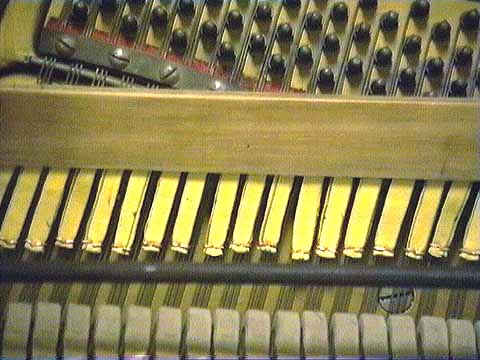
Typical appearance in a vertical piano, shown here in the Fratihymnia
orchestrion being restored by Willy van der Reijden, Almelo, The Netherlands.
Willy says the Frati company called it the "harp effect". The supporting
fabric and the suspended metal piece are aligned with the face of the hammer
(not aligned with the strings). Horizontal alignment is critical,
else two notes may sound together! The hammer face strikes the thin
supporting strap just above the metal piece. |
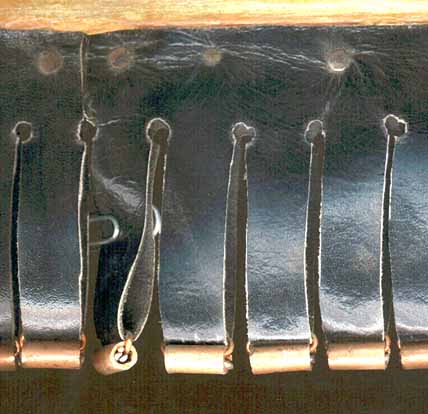
Back side (nearest the strings) of the "mandolin" device in an early
Seeburg nickelodeon. The copper tube is 0.125" (3.2 mm) i.d.,
0.188" (4.8 mm) o.d., 0.425" (10.8 mm) long, and the attachment loop is
0.038" (1 mm) o.d. copper wire. Scraps of copper and steel wire fill
the inside, for added weight. (A lead alloy, such as solder, might
also be used to fill the tube.) |
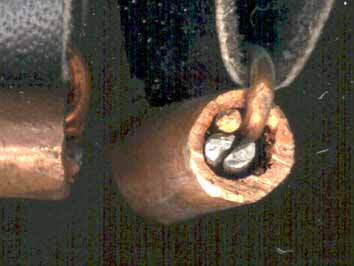
The support strap is imitation leather, thickness 0.015" (0.4 mm). |
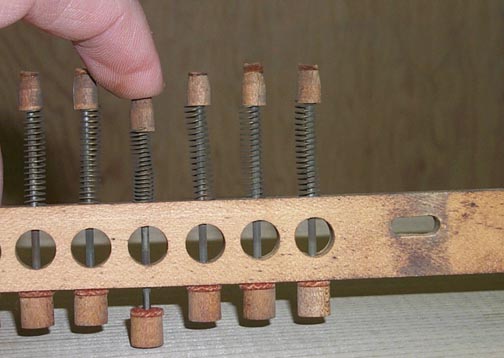
(Photo by B Bronson)
This is very familiar in the full size Coinola nickelodeon. I
don't know if it was used in the Midget series It is actually
a wooden slat drilled precisely through the thin dimension so that there
is a guide hole for the notes on the treble end. A metal rod goes
through the hole with a wooden button each end.
The system is installed between the hammers and the strings and has
slotted holes in the slat which fit over pegs that allow it to move left
and right. When the music roll calls for the mandolin effect, a pneumatic
pulls the system to the right, placing the back end of each rod in front
of the hammer shank. As the note plays, the shank hits the rod, throwing
it at the string, which is hit with the front button. The rod is
returned by a light coil spring.
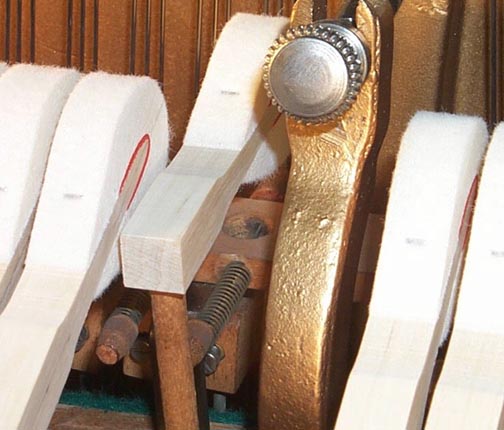
With the mandolin "off", the hammer shanks fly up between the rods.
The ones I have seen have been engineered to require the rod to hit the
string from momentum. In other words, if one gently pushed the hammer
fully, the rod would not be touching the string.
Another variation on the hanging strip theme was that used in the Nelson-
Wiggens. I have seen a couple that appeared to be quite original
which used a pump type cloth with a thin (1/8") wood piece glued on each
strip. The few I have seen appeared to have the wood directly between
the hammer and string.
More Coinola photos at mandolin2.html.
B Bronson
Fri, 7 Jan 2000 14:41:09 -0500 |
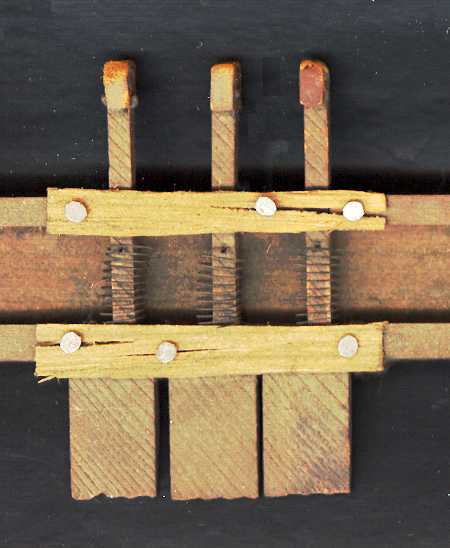
The Marquette Cremona usually had this plunger style mandolin device.
The thin wood wedges resemble a tiny paddle for handling pizza in a hot
oven! A thin piece of leather covers the end of the plunger stick,
which is struck by the hammer shank. A tiny coil spring returns the
plunger to its rest position.
When it's properly adjusted the hammer shank does not force the plunger
into the strings; rather, the hammer shank propels the plunger like a cue
stick hitting a billiard ball. The plunger actually strikes the strings
and rebounds before the hammer hits the strings.
The ends of the paddles shown in the photo are quite worn because the
hammers became worn and were filed, so the hammer shank actually forced
the paddle into the strings. This also caused rapid deterioration
of the leather. |
Return to MMD Tech site.
7 January 2000, 19 April 2003
|
 Gallery
Gallery
 Tech
Tech
 mandolin
mandolin





